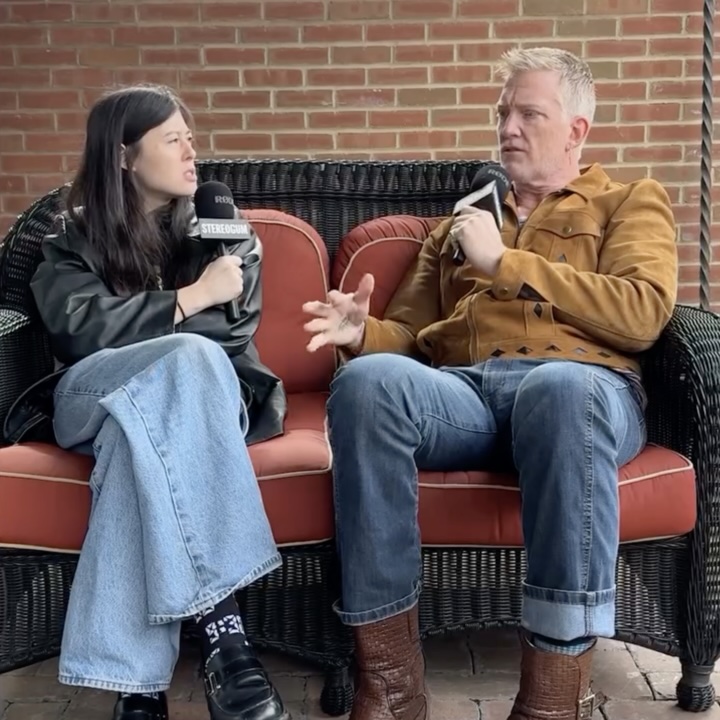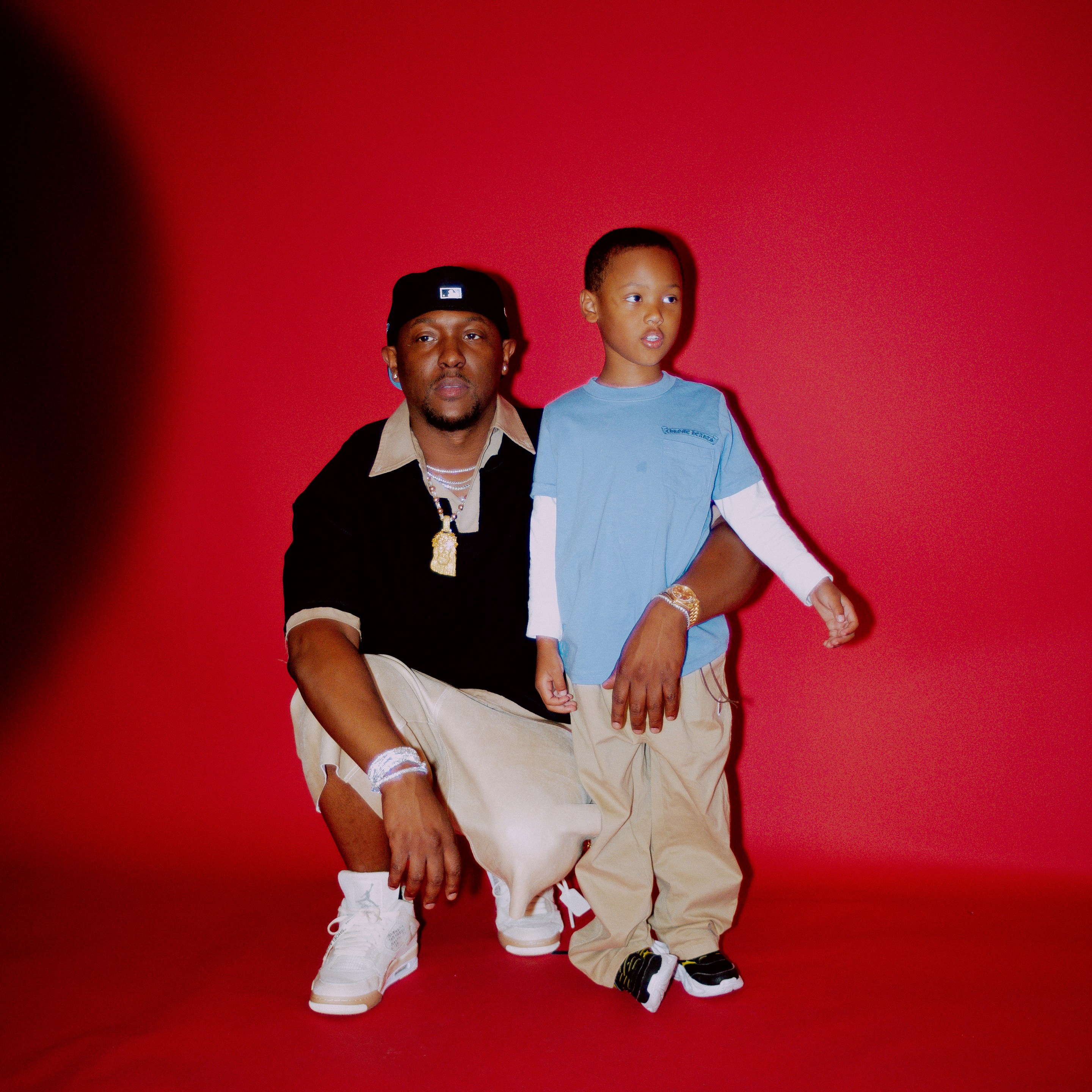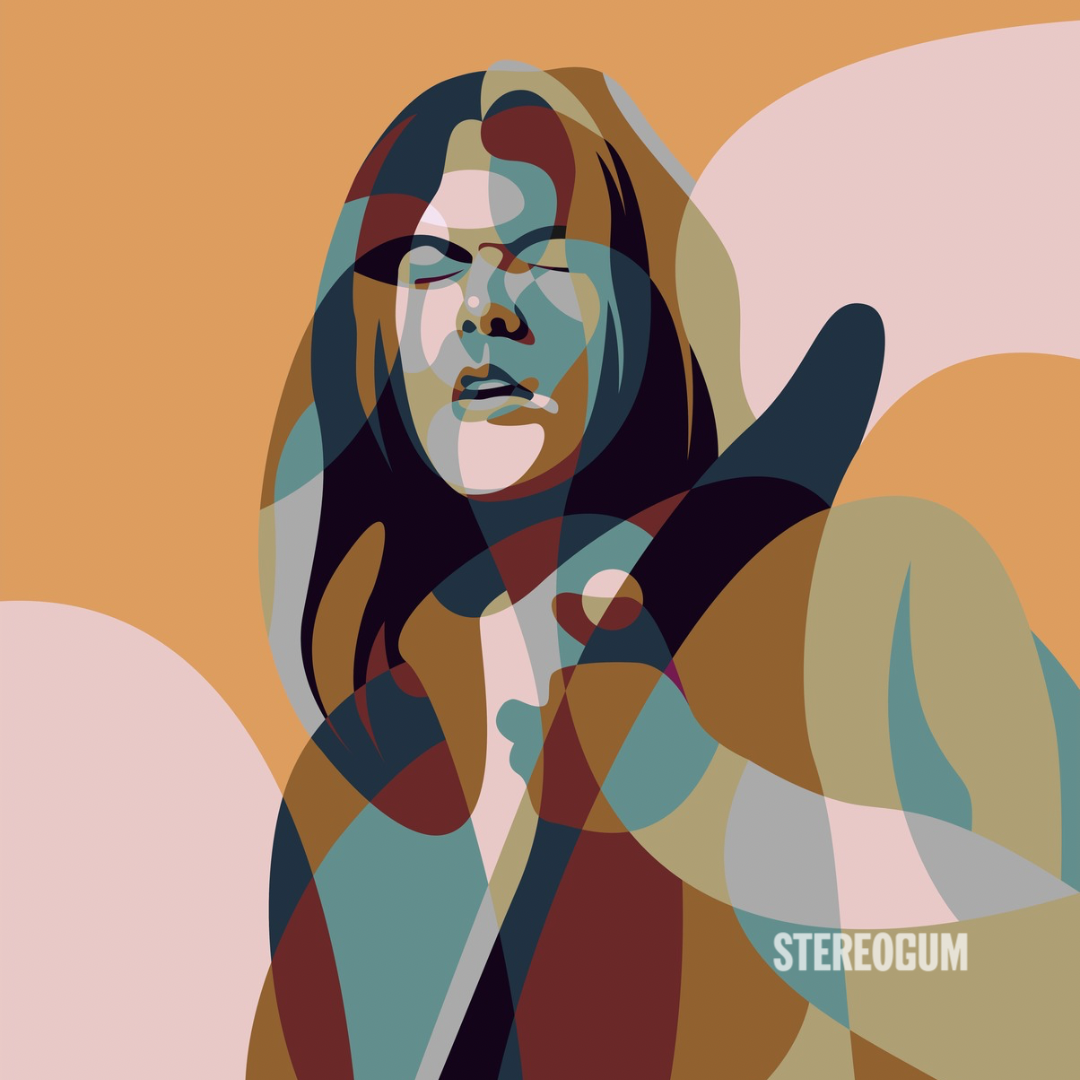On the opening track of the Range's new album, Potential, project mastermind James Hinton samples the voice of YouTube rapper SdotStar (current view count: 1,450): "Right now, I don't have a backup plan for if I don't make it... But even if... I'll just decide to move on... to something bigger and better..." He clips the words at deliberate intervals, doubling back and twisting the phrasing to mean multitudes. You can feel the hopefulness associated with "making it," the bracing failure that will come if you don't. But as much as it's implying all of those things, it's also not -- the song allows you to make your own inferences, draw conclusions for yourself about the story behind the voice, the narrative behind the song.
For his Domino debut, Hinton scoured the depths of YouTube to find musicians and artists who had a spark, something that he could be influenced by or morph for his own uses. What could easily be a voyeuristic vanity project in the wrong hands is in fact a transcendent experience here. His treatment of the people that he samples is considered and thoughtful; instead of coming across as exploitative, it feels like he's tapped into a previously unknown range of human emotions. By re-contextualizing these stray YouTube samples from around the world, he's found the connective tissue that holds us all together. It's something he's explored in fits-and-starts on his previous releases, like 2013's Nonfiction and its followup EP Panasonic, but for Potential he decided to really dig deep into what it means to sample a voice in the current internet age where there's an unlimited amount of content to draw from.
The answer he's settled on is multifaceted: Each sampled voice on Potential goes unnoticed at first glance -- there's no featured credits clogging up the framework. It allows for a degree of anonymity, a way to sink into the characters without any real-world bias. But the extracurriculars surrounding the album are focused on shining a spotlight on the people behind the voices: There's a documentary, forthcoming, that offers a look into lives of some of those who were sampled; the video for "Five Four" has sampled rappers ST and Ophqi in the flesh. Hinton is eager to give credit where it's due, something I learned when I sat down for a conversation with him at a diner near his apartment in Brooklyn last month. Read our lengthy talk about his new album below.
[videoembed size="full_width" alignment="center"][/videoembed]
STEREOGUM: Sonically, what did you want to explore on Potential compared to your other releases?
JAMES HINTON: I wanted it to be a little more specific per song. Nonfiction was trying to bridge the gap between a lot of music in the UK at the time -- like grime -- with stuff that was happening in the US -- like footwork. Back when I was still with [Brooklyn-based label] Astro Nautico, we threw a lot of parties where there was always this footwork element present, but never a specific quoting of it. At the time, I was still trying to think through that tempo, but in retrospect I think I was just throwing a lot of things at the wall and seeing what would stick. Whereas for Potential, I wanted to be more specific about how those pieces fit, and not be so beholden to the tempo that you need [for that kind of music]. Like, do those ideas extend outside of that sort of 160 - 172 beats per minute?
[Opening track] "Regular," for instance, is an interesting case because it's definitely taking on a grime template, but it's nowhere even close to that sound. A lot of the palette -- in terms of the low end, the bass structure, the harshness of the bass -- is similar, but it's also much slower and spread out and less rhythmically complex, more to the point. Those are all of the decisions I was trying to figure out while making this record ... The ideas are relatively the same, but it's a rehashing of it. Kind of thinking: OK, where do they extend [past that] in terms of tempo and palette?
STEREOGUM: You originally started off as a drummer. Do you still approach constructing a track through that perspective?
HINTON: I definitely tried to be a little more evenhanded this time around -- a lot of drummers just start with a rhythm track or a beat, but I think that's actually relatively rare on this record. Most of the palettes started with the actual YouTube samples -- something that caught my ear -- and then I tried to extend that into something that lends itself to more harmony decisions. There was an active choice not to ... start out with a really active rhythm track, because then it's difficult to make sure that everything else has room to breathe.
STEREOGUM: So when you're making a track, you typically come across a clip that inspires you? Or do you find things to slot in afterwards?
HINTON: A little bit of both. Because I was actively searching all the time, there were basically two forms it would take: 1) Just me watching YouTube, or someone would send me a link to something and I'd find myself in the related videos and happen upon a good clip, or 2) a more pointed search. I had this set of four or five search times that were very hyper-specific that I would go to. Depending on [the method I found the clips with], I would let that guide where the track went. Because for the more pointed ones, I had the track ready to go -- or at least more fleshed-out -- whereas if I found something, I would try to create off of that. So, again, [the album] is a little bit even-handed because I didn't impose any rules on myself, like that I had to find a sample on YouTube first or anything. I think the record's much more musical because of that freedom.
STEREOGUM: You used the same sampling process for Nonfiction. Why did you feel it was important to highlight your curation process this time around? What changed in the time between the two records?
HINTON: I think a lot of it was just being more interested in the intellectual side of the [sampling process]. Nonfiction has maybe five pretty prominent YouTube samples, but then there are other samples on there that are not in that vein. Like, there are some that are vocals and some that are à capella, but they're not explicitly "YouTube people" in that sort of mode. When I finished Nonfiction, songs like "Jamie" and "Metal Swing" were the ones that stuck with me, and that I found really interesting after the fact because you're kind of capturing this moment in time. Last time, I was more excited about finding vocals for instrumentation I had already done. This time, I was most excited about capturing [that moment], and that's why I thought it was important to highlight the narrative. It exists on Nonfiction, but I think it's much more honed and thought-out [on Potential], or at least I hope so.
STEREOGUM: It seems like the mood you're going for on this record is hopeful, even uplifting at points, but in this kind of defeatist way that's a little depressing if you think too much about it... Do you think the reason why you focused so much on sampling these specific types of [Youtube hopefuls] was that your instrumentation was gravitating towards that feeling?
HINTON: I think it's important to try and let a paradox like that live, and not be too specific about it. I do think both are true. You have this song and you hatch it and come up with the main ideas in a sort of burst, but as you live with it, the music will change. Or the part of the sample that you want to highlight will change until it sort of becomes this reflection of itself. The vocal will be reflected in the song and, I think, the song will end up kind of re-reflecting what the vocal means. Like on "Falling Out Of Phase" [which samples a cover of Keyshia Cole's "Fallin' Out"], the original song is very much an empowering thing, but given the presentation and context I put it in, there's a huge amount of longing that I was definitely feeling at the time. The way the song's structured forces that angle.
I do think it's weird that once you introduce something significantly new a month into a track's existence, whatever the original idea was will always be present, but the whole track feels like the sum of what you've experienced. There was a time when I was writing quite a bit in the UK and it was much more gloomy, and I think it ended up making the songs straddle those two lines that you were talking about in terms of the optimism that's associated with that kind of hopefulness. "Regular" is a good case of that: This idea of making it and success, some sort of abstract notion of feeling good about your progress in life. But then, obviously, when you set that up for yourself and it's not quite working out or you're nervous about it, then it's a reflection of the depressing aspect to it. So I do kind of like that the record is presenting both sides.
STEREOGUM: So I guess that's where the title Potential comes from?
HINTON: I really like the idea of potential energy. It's like, all you can really do, especially in any musical or artistic endeavor: Walk this piece of art that you're working on, and climb the stairs until it gains this amount of energy. It doesn't really mean anything until you release it and let it out into the world, but you lose that control. I like that metaphor.
I'm a bit of a sucker for dual meanings: I liked the idea of the YouTube star, and that a lot of people are going to reflected in that light because the narrative is so prominent. Going back to people like Justin Bieber and Charlie Puth, that's a really well-formed thing in terms of what a lot of people assume will happen when they step in front of the camera. That that's what they're attempting.
But as we started contacting the [people that I sampled], I found that was very much not the case, and that narrative was not necessarily the reason these people were putting stuff out there. There was a lot of catharsis, a lot of just being excited to release something into the world. Everyone had different reasons for [uploading a video], and I think that potential to me is captured in the title as well. You're sort of removing expectation from it, just releasing this thing and kind of seeing what gets taken up. So I got comfortable enough with that being just specific enough for me and my relationship with the project, as well as the people that are featured on the project in relation to me. Hopefully, [the album] captures that two way street a little.
STEREOGUM: At least in my eyes, your music is a little more attuned to traditional songwriting, using these samples to create a narrative. Is that something you set out to do in terms of setting a mood, having this extra element of a story?
HINTON: Yeah, that's super important. I'm hoping that gets read into, especially when the record actually comes out. The tracklisting is super specific, a lot of the intro song ordering especially. I'm happy that the original YouTubes are out there in the world -- hopefully it will drive people to them, because what I've cut and changed and re-ordered is all very specific. That's definitely part of the challenge.
For Nonfiction, I was primarily just doing random YouTube searches, so I wasn't really lyric-writing in that sense. So Nonfiction has much shorter phrases that are just repeated, whereas this one was much more fleshed-out. "Five Four" is a great example of me trying really heavily to re-contextualize longer phrases. It's always inappropriate to just lift a whole set of lyrics and place it over a beat -- I think that's been done before. But, to the extent possible, I was really trying to heavily enforce that narrative of reflecting back on what the people mean lyrically, and also how that reflected on myself.
[videoembed size="full_width" alignment="center"]
[/videoembed]
STEREOGUM: In the case of the tracks that sample covers of more popular songs, what do you think the benefit of using a cover is as opposed to just remixing the original?
HINTON: I think I came to those songs from the search terms and was less interested in, say, that specific Keyshia Cole song than the fact that the video for the cover was in front of a shower curtain. I found that it was quite random and interesting. Then, obviously, once she sang, I realized she was an incredible singer. I'm quite happy that those songs are on the album because I think they reflect a different presentation of how people think about pop music. When it's just in their head and they're not accompanied at all by backing music, the tone is incredibly different.
Like [on "Florida," which samples a cover of Ariana Grande's "You'll Never Know"], Ariana Grande's version is very upbeat and the tempo is way faster compared with how Kai sang it. It felt good to me that, in that moment, Kai was feeling rejected and that was her emotional response to singing "you'll never know," whereas I don't think that's the angle for Ariana Grande.
I think it has something to do with the structure of pop music in general. For the Keyshia Cole song as well, there's a set of songwriters that are involved and the song is probably a lot more fleshed-out before it reaches the singer. Whereas [with the covers], it's nice that the whole package gets reflected into an individual first. It's a way to recreate an individual experience out of the results of a songwriting camp, especially when something like Rihanna's process is so well-known. It brings the natural back into it. I don't necessarily like the context of Ariana's version because she's such an amazing singer -- it's better when reflected through someone who is more earnest and less focused on just destroying notes.
STEREOGUM: Yeah, because an amateur singer is a little less sure of themselves. Where do you see the divide between pop production and what you're doing? With a lot of pop songs, the tempos may be different, but they largely have the same verse-chorus structure. What's the difference between people who are producing these songs for professionals, and what you're doing by incorporating voices after the fact?
HINTON: I think people that are writing those structures are bending to a historical kind of "single" structure. Yeah, there's that whole idea of album tracks vs. single tracks, but no one sets out to write an album track. You're really trying to hone in and nail certain spots -- the vocals have got to be in by 20 seconds, you need to reach some sort of peak by a minute-and-a-half. "Florida" is a great example where that [formula] came around kind of naturally, and it felt really good to be somewhat in that palette, but then "Four Five" is a song that isn't really interested in that world at all. I think a lot of it has to do with the intention behind the music -- do you want this project to be on radio? -- and that guides the process throughout. For me, it was always much more about trying to do me as opposed to trying to do structure. It's a happy accident that the album ended up being a nice vector for people, because at the end of the day the narrative reflects around YouTube.
STEREOGUM: In terms of the YouTube clips, when did you decide that you were going to actually reach out to the people you sampled and see if they want to be used on the record?
HINTON: It really started with "1804," the last song on the album. [The track samples] this guy Damian, whose project was like a songbook -- every week he shows it in the video, bundles and bundles of song lyrics written down and he's just ticking them off one by one every week, singing them à capella. It felt like a throwback to an ages old sort of thing. I got really curious just to see what the guy was like, and then once I reached out to him I was like, oh my god, he's the coolest dude in the world. He approaches music in the same way I do, always working and wanting to get better. Obviously, it's a totally different thing, but it was so cool that I was like ... I have to meet everyone. This is too interesting.
It took me a while to find him, to find everyone. YouTube messaging is not great. I don't check my YouTube messages, no one does. So obviously you start there, but then what's next? Phone books? It was quite a defective process. But it was kind of fun to track everyone down. And I felt really empowered by it. That, because of the forced delay, all of the songs were already in their final form by the time I got in touch with everyone, so it was pretty good to be able to just bring them to it. And the response was uniformly positive, which I was surprised by. I mean, I think [the music] is accessible to some degree, but the fact that everyone was more or less ecstatic once they got over the initial shock of being like, "Are you trying to scam me?," was very exciting to me.
[videoembed size="full_width" alignment="center"]
[/videoembed]
STEREOGUM: Was there anyone that outright said, "No, I don't want to be involved with this"?
HINTON: Umm... I don't think so. Zak, who's on "Copper Wire," was very confused at first. Like, "What do you mean you're using it? What does that mean?" At first I thought he was not cool with it, but then I realized that... Like, what would you think if someone came to you after you posted a video and asked to use it? What would you assume?
STEREOGUM: Probably that someone was making fun of me.
HINTON: Exactly. I think his video had something like 3,000 views, but it was from so many years ago. He was like 13 at the time. There's a lot of steps you have to mentally go through to assume that the other person is like, "No, I'm really earnest. I love this so much." I would have assumed the same thing. I was really surprised that attitude wasn't more prevalent. Once a lot of people heard the music they were like, "Oh shit, this is serious and good and we like it," so I was happy about that.
STEREOGUM: How was meeting with the [sampled people] for the first time, since you've kind of been making assumptions and judgements about them based on this one YouTube clip as you're going through your creative process?
HINTON: It's sort of just confirming and denying evidence. I think I there's a tendency to just assume that you know everything, or at least I ended up thinking that I knew so much about this person from this very specific thing, which of course is insane, but you do get a lot. Like Damian [from "1804"] was really confirming because I had assumed based on the fact that he had written all these songs that he had logged all of these thousands of hours on the project, which of course was confirmed. But then the fact that he was a prison guard, I never would have assumed, or that he's not full-time doing music, I probably wouldn't have guessed. That was impressive. Then for ST and Ophqi, who are on "Four Five," I was impressed that ST is much more into the producing side of things -- like, he actually works in a studio and is at it all day. I think that's quite a rare combination -- to be that good at freestyling and also to produce. That was an amazing surprise.
So it was a lot of fleshing out what you assume is a sort of one-dimensional character because you only have one YouTube video. Like, yes, a lot of people have channels, but a lot of time the one video was all I ended up watching, or the only thing they had available. So you have this one thing that's so specific, and you end up living with it for a long time and contextualizing it based on the music [I made] and the vibe of the [existing track]. So with ST and Ophqi, I was like, "Oh, they're from London, and really grim." But they're very pleasant, upbeat and positive people. Which, yeah, most people are. But you assume ... you think so much about what he's saying, that it's a mindfuck when you find out otherwise.
[videoembed size="full_width" alignment="center"]
[/videoembed]
STEREOGUM: With the documentary, when did you come to the decision that you wanted to film all of these interactions, or was that a natural thought process?
HINTON: I think it was something that became clear to me when it was obvious that the narrative YouTube aspect would be so important to the album. I was so aware of the YouTube collage thing -- which I guess is less in vogue now but was big when I was in school, like AutoTune The News. That sort of thing is not a new idea, and obviously sampling in general is not a new idea, but it just became clear to me that this is sort of similar to crate digging, but also radically different because it's actual people. Someone has a story, and once it clicked with me that their story is equally important, it made sense to pursue the documentary.
There's two different modes: The world in which I've chosen to kind of lift their story into with my music, but then they're living their lives and exist outside of it. I think to know one, you need to know the other. So once I began thinking about it in that way, we started putting out feelers about the documentary. Some people didn't want to be on camera, but others were excited enough that we started to figure out the logistics of getting a film crew and doing interviews to see where everyone was at.
STEREOGUM: Did signing to Domino spur these larger ambitions?
HINTON: Yeah, certainly. I think that with any label that's not on their scale, a lot of this just wouldn't be possible. When you finish a project, it takes a bit of time.
To think of the Range as a series of things... I don't like the idea of producers jumping and hopping from genre to genre. I like to think of this project as kind of slow, explicit... I'm trying to draw a line over time with this project that is all connected, and so it was important that this was something connected to Nonfiction, but not the same thing. I think when I started to get this idea of the YouTube narrative, we were also finishing negotiations with Domino, so it was all happening at the same time. I think it's important that there's resources behind the project, because it shows that you don't have to be a star to have music that speaks to people and can be emotionally relevant and tick all of the right boxes.
I'm really hyper-motivated by the idea that my process is equally as valid. It's never gonna be shiny, it's never gonna be this thing. But in terms of being a package that's relatable, it's eminently that. And I think the documentary was a huge undertaking that took lots of time and money, but I'm convinced that it will aid the cause for this record and all my future records. I'm always thinking about how people perceive me, if they see some weirdo kid who's in his own head about the YouTube thing. But to have someone validate that and be excited about it was amazing. You just don't know how people are going to react to something like that, but for them to be supportive is really great.
[videoembed size="full_width" alignment="center"]
[/videoembed]
STEREOGUM: Were you worried about the reaction to the record in that sense? Like, when I first heard about the project, I definitely went through an initial period where I thought, Oh, he's just using these people's samples in a kind of fucked up and exploitative way, but the more I listen to the record, the more I realize that it's not the case. But were you worried, being inside of your own head so much, that that's how it would come across?
HINTON: Yeah. I think because, like you said, you can spin it any way you want depending on the details, and the way someone percieves the project at a different stage. I mean, anything with sampling, I think a lot of people assume that there's no contact, no clearance. That it's me just rummaging through YouTube and that it's somewhat voyeuristic. I think that's why it's important to be patient and to constantly talk about the process, because it's important. I think that both narratives are valid. It's really personal to me, but I think of the record as a platform to lift people up song by song.
It's not easy. People are so inundated with material that there's gonna be a percentage of people that read some byline and have that initial reaction. You just have to have faith that people will stick with it. Because I do think there would have been a way to have this sort of feature-heavy project, but I think in terms of personalizing it ... it just feels like [the record] is doing right by everyone involved. Going back to the idea of crate digging, there has been a line of thought that's like, "You're the guy that is the smart one because you found this record at the bottom of the stack."
I love stuff like Kanye sample spotting, and stuff from the '90s like the Beastie Boys ... They were geniuses for finding that stuff, but I think now as YouTube has come to light, you realize that there was always another person at the other end of that record that you found. With YouTube, it's eminently clear because it's a physical person, and that they're just as an important of a person to have a conversation about.
STEREOGUM: Have you thought about a live set up? Obviously, most of it will be your traditional DJ set, but have you looked into the possibility of having some of these people perform with you?
HINTON: Yeah. I think the biggest thing is obviously coordination, and making sure it makes sense in the context in which it's presented in. Obviously, it's a tough choice because it would be impossible to go on tour with everyone [that's sampled], and if you only have a few people does it service the whole record? It would be cool, but I'm also aware that a lot of people have lives, and they might not be interested. But for the people that are interested in something like that, I'd want to do whatever I can to be some sort of platform. Im quite small, but if there's any light I could shine on these people... Because they're so good. They represent maybe 5% of the videos that I watched -- they're the cream of the crop. I think if they want careers, they should be able to have them.
STEREOGUM: You mentioned earlier that that's an obvious through line from Nonfiction to Potential. What's the next logical step from here?
HINTON: I think I'm still in the clouds right now, but there's one more kind of turn of the screw that I think a lot about: Am I involved? Is there some scenario where my voice is coming back into the process? There's a challenging element that I always dance around in terms of trying to create longer and longer phrases to work with. There's only one song on the record -- "Copper Wire" -- that uses two YouTube samples that are coexisting. That was intriguing to me because it's hard to find something that fits within a palette, let alone two different vocal samples that work together. I think that's quite a convincing thing, but I'll never know until I just write a song so we'll see. I'm excited about it, though. I started work on some newer stuff and it seems like it's moving along in a new direction.
Potential is out 3/25 via Domino.






